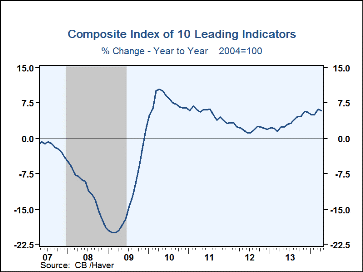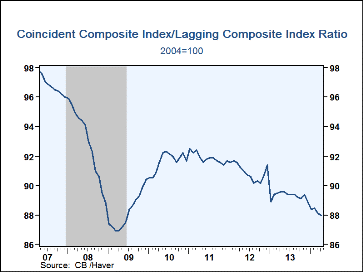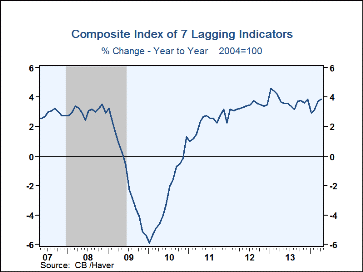 Global| May 22 2014
Global| May 22 2014U.S. Leading Economic Indicators Point Toward Improved Economic Growth
by:Tom Moeller
|in:Economy in Brief
Summary
The first quarter's economic stagnancy looks to have been a hiccup, according the Index of Leading Economic Indicators. The Conference Board reported that the index advanced 0.4% last month, the third month of firm increase following [...]
The first quarter's economic stagnancy looks to have been a hiccup, according the Index of Leading Economic Indicators. The Conference Board reported that the index advanced 0.4% last month, the third month of firm increase following two of little change. The increase matched expectations in the Action Economics Forecast Survey. The breadth of component gain was a lessened 60%. A steeper interest rate yield curve and more building permits accounted for most of the index rise last month followed by the leading credit index and new orders for consumer goods.
A lower ratio of coincident-to-lagging indicators continued to temper the message of positive economic growth to come. It slipped to its lowest level of the economic recovery. The index measures how the economy is performing versus its excesses.
The index of coincident indicators nudged 0.1% higher (2.1% y/y) following 0.3% gains in the prior two months. Last month, higher payroll employment, increased personal income less transfers and improved manufacturing & trade sales accounted for the overall index rise. Industrial production pulled the index lower for the first month in the last three.
The index of lagging economic indicators increased 0.2% last month (3.9% y/y) following a 0.7% March rise. Another surge in C&I loans outstanding and a shorter duration of unemployment accounted for the rise.
The Conference Board figures are available in Haver's BCI database; the components are available there, and most are also in USECON. The forecast figures for the Consensus are in the AS1REPNA database. Visit the Conference Board's site for coverage of leading indicator series from around the world.
| Business Cycle Indicators (%) | Apr | Mar | Feb | Y/Y | 2013 | 2012 | 2011 |
|---|---|---|---|---|---|---|---|
| Leading | 0.4 | 1.0 | 0.5 | 5.8 | 3.4 | 2.2 | 5.3 |
| Coincident | 0.1 | 0.3 | 0.3 | 2.1 | 1.9 | 2.3 | 2.6 |
| Lagging | 0.2 | 0.7 | 0.2 | 3.9 | 3.8 | 3.4 | 2.3 |
Tom Moeller
AuthorMore in Author Profile »Prior to joining Haver Analytics in 2000, Mr. Moeller worked as the Economist at Chancellor Capital Management from 1985 to 1999. There, he developed comprehensive economic forecasts and interpreted economic data for equity and fixed income portfolio managers. Also at Chancellor, Mr. Moeller worked as an equity analyst and was responsible for researching and rating companies in the economically sensitive automobile and housing industries for investment in Chancellor’s equity portfolio. Prior to joining Chancellor, Mr. Moeller was an Economist at Citibank from 1979 to 1984. He also analyzed pricing behavior in the metals industry for the Council on Wage and Price Stability in Washington, D.C. In 1999, Mr. Moeller received the award for most accurate forecast from the Forecasters' Club of New York. From 1990 to 1992 he was President of the New York Association for Business Economists. Mr. Moeller earned an M.B.A. in Finance from Fordham University, where he graduated in 1987. He holds a Bachelor of Arts in Economics from George Washington University.










